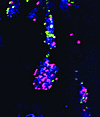Citation Information: J Clin Invest. 2004;113(2):160-168. https://doi.org/10.1172/JCI20761.
Abstract
Mammalian aging occurs in part because of a decline in the restorative capacity of tissue stem cells. These self-renewing cells are rendered malignant by a small number of oncogenic mutations, and overlapping tumor suppressor mechanisms (e.g., p16INK4a-Rb, ARF-p53, and the telomere) have evolved to ward against this possibility. These beneficial antitumor pathways, however, appear also to limit the stem cell life span, thereby contributing to aging.
Authors
Norman E. Sharpless, Ronald A. DePinho
Citation Information: J Clin Invest. 2004;113(2):169-174. https://doi.org/10.1172/JCI20784.
Abstract
Damage to DNA, the prime target of anticancer therapy, triggers programmed cellular responses. In addition to apoptosis, therapy-mediated premature senescence has been identified as another drug-responsive program that impacts the outcome of cancer therapy. Here, we discuss whether induction of senescence is a beneficial or, rather, a detrimental consequence of the therapeutic intervention.
Authors
Pascal Kahlem, Bernd Dörken, Clemens A. Schmitt
Citation Information: J Clin Invest. 2004;113(2):175-179. https://doi.org/10.1172/JCI20800.
Abstract
Stem cells generate the differentiated cell types within many organs throughout the lifespan of an organism and are thus ultimately responsible for the longevity of multicellular organisms. Therefore, senescence of stem cells must be prevented. Bmi1 is required for the maintenance of adult stem cells in some tissues partly because it represses genes that induce cellular senescence and cell death.
Authors
In-Kyung Park, Sean J. Morrison, Michael F. Clarke
Citation Information: J Clin Invest. 2004;113(1):4-7. https://doi.org/10.1172/JCI20750.
Abstract
Stem/progenitor cells ensure tissue and organism homeostasis and might represent a frequent target of transformation. Although these cells are potentially immortal, their life span is restrained by signaling pathways (p19-p53; p16-Rb) that are activated by DNA damage (telomere dysfunction, environmental stresses) and lead to senescence or apoptosis. Execution of these checkpoint programs might lead to stem cell depletion and organism aging, while their inactivation contributes to tumor formation.
Authors
Pier Giuseppe Pelicci
Citation Information: J Clin Invest. 2004;113(1):8-13. https://doi.org/10.1172/JCI20663.
Abstract
Cells entering a state of senescence undergo a permanent cell cycle arrest, accompanied by a set of functional and morphological changes. Senescence of cells occurs following an extended period of proliferation in culture or in response to various physiologic stresses, yet little is known about the role this phenomenon plays in vivo. The study of senescence has focused largely on its hypothesized role as a barrier to extended cell division, governed by a division-counting mechanism in the form of telomere length. Here, we discuss the biological functions of cellular senescence and suggest that it should be viewed in terms of its role as a general cellular stress response program, rather than strictly as a barrier to unlimited cycles of cell growth and division. We also discuss the relative roles played by telomere shortening and telomere uncapping in the induction of senescence.
Authors
Ittai Ben-Porath, Robert A. Weinberg
Citation Information: J Clin Invest. 2003;112(11):1620-1625. https://doi.org/10.1172/JCI20442.
Abstract
Quorum sensing via the accessory gene regulator (agr) system has been assigned a central role in the pathogenesis of staphylococci, particularly Staphylococcus aureus. While the control of virulence gene expression in vitro by agr has been relatively straightforward to describe, regulation of both the quorum response itself and virulence genes in vivo is considerably more complex. The quorum response is highly dependent upon the environment in which the organism is grown and is strongly influenced by additional regulators that respond to signals other than cell density. There is increasing evidence that the agr phenotype may influence the behavior and pathogenesis of biofilm-associated S. aureus and S. epidermidis and may contribute to the chronic nature of some biofilm-associated infections.
Authors
Jeremy M. Yarwood, Patrick M. Schlievert
Citation Information: J Clin Invest. 2003;112(11):1626-1632. https://doi.org/10.1172/JCI20430.
Abstract
Members of the bacterial genus Streptococcus are responsible for causing a wide variety of infections in humans. Many Streptococci use quorum-sensing systems to regulate several physiological properties, including the ability to incorporate foreign DNA, tolerate acid, form biofilms, and become virulent. These quorum-sensing systems are primarily made of small soluble signal peptides that are detected by neighboring cells via a histidine kinase/response regulator pair.
Authors
Dennis G. Cvitkovitch, Yung-Hua Li, Richard P. Ellen
Citation Information: J Clin Invest. 2003;112(10):1460-1465. https://doi.org/10.1172/JCI20364.
Abstract
Pseudomonas aeruginosa has two complete quorum-sensing systems. Both of these systems have been shown to be important for Pseudomonas virulence in multiple models of infection. Thus, these systems provide unique targets for novel antimicrobial drugs.
Authors
Roger S. Smith, Barbara H. Iglewski
Citation Information: J Clin Invest. 2003;112(10):1466-1477. https://doi.org/10.1172/JCI20365.
Abstract
Unequivocal direct observations have established that the bacteria that cause device-related and other chronic infections grow in matrix-enclosed biofilms. The diagnostic and therapeutic strategies that have served us so well in the partial eradication of acute epidemic bacterial diseases have not yielded accurate data or favorable outcomes when applied to these biofilm diseases. We discuss the potential benefits of the application of the new methods and concepts developed by biofilm science and engineering to the clinical management of infectious diseases.
Authors
William Costerton, Richard Veeh, Mark Shirtliff, Mark Pasmore, Christopher Post, Garth Ehrlich
Citation Information: J Clin Invest. 2003;112(9):1288-1290. https://doi.org/10.1172/JCI20099.
Abstract
The existence of species-specific and interspecies bacterial cell-cell communication and group organization was only recently accepted. Researchers are now realizing that the ability of these microbial teams to communicate and form structures, known as biofilms, at key times during the establishment of infection significantly increases their ability to evade both host defenses and antibiotics. This Perspective series discusses the known signaling mechanisms, the roles they play in both chronic Gram-positive and Gram-negative infections, and promising therapeutic avenues of investigation.
Authors
E. Peter Greenberg
No posts were found with this tag.



Copyright © 2025 American Society for Clinical Investigation
ISSN: 0021-9738 (print), 1558-8238 (online)










